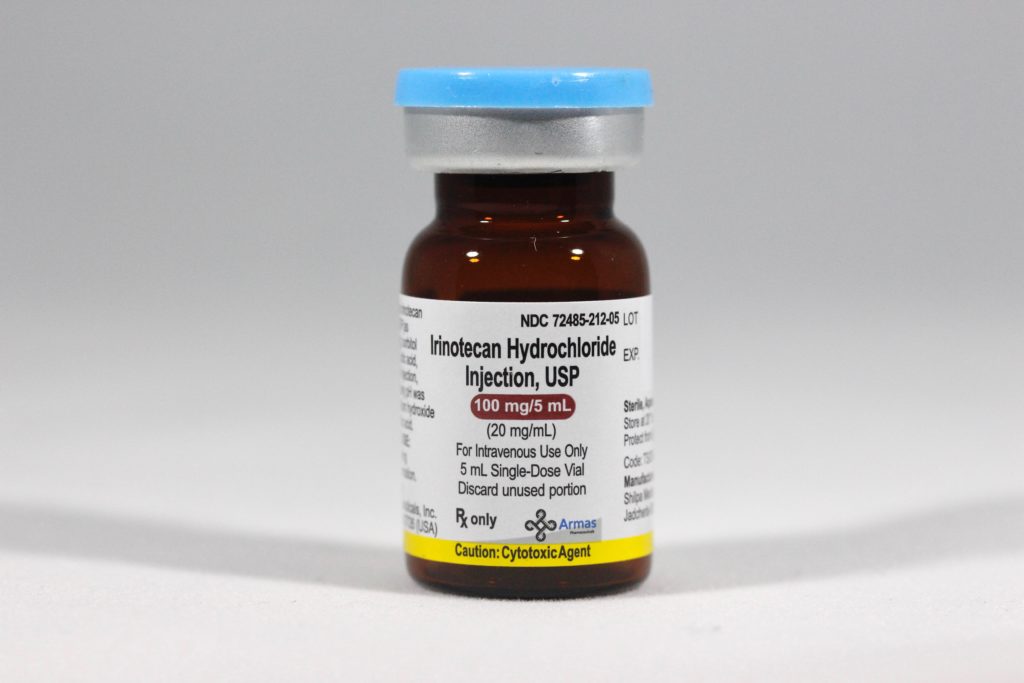What is Irinotecan?
Irinotecan is used to treat colon and rectal cancers. It is typically given in conjunction with other cancer medications.
Irinotecan may be used for additional conditions not listed in this medication guide.
Irinotecan uses
Irinotecan is used to treat metastatic colorectal cancer. Additionally, it is used in combination with cisplatin to treat extensive small cell lung cancer. Irinotecan is currently being studied for the treatment of cervical cancer that has metastasized or recurred. Additionally, it is used in combination with fluorouracil and leucovorin to treat patients with metastatic pancreatic adenocarcinoma following gemcitabine-based therapy.
Mechanism of action
DNA topoisomerase I is required for DNA double helix relaxation during replication and transcription.
The enzyme accomplishes this by introducing single-strand breaks into the DNA, thereby freeing it from supercoiling. Irinotecan is a prodrug that acts on the S and G2 phases of the cell cycle by inhibiting DNA topoisomerase I. Through the action of a carboxylase-converting enzyme, irinotecan is activated to its biologically active metabolite, SN-38. UDP-glucuronyltransferases activity converts SN-38 to its SN-38G form. form
Irinotecan dosage
- For initial pelvic and/or abdominal radiation, a dosage reduction of at least one dose level should be considered if the patient has a performance status of 2 or is known to be homozygous for the UGT1A1*28 allele (subsequent dosing/adjustments should be based on individual tolerance).
- Irinotecan (conventional) is NOT interchangeable with irinotecan (liposomal).
- Dosage varies according to formulation; before preparing and administering, verify the intended product and dose.
- Premedication with atropine 0.25–1 mg IV or SubQ should be explored in patients with cholinergic symptoms (such as increased salivation, rhinitis, miosis, diaphoresis, abdominal cramping) or early-onset diarrhea.
Irinotecan Dose as a monotherapy in metastatic cancer
Weekly regimen: 125 mg/m2 administered over 90 minutes on days 1, 8, 15, and 22 of a 6-week treatment cycle (may increase to 150 mg/m2 if tolerated).
Dose adjustment level -1: 100 mg/m2 o Dose adjustment level -2: 75 mg/m2
- Once-every-three-week regimen: o 350 mg/m over 90 minutes, once every three weeks o Adjusted dose level -1: 300 mg/m2
Adjusted dose level -2: 250 mg/m2 o If necessary, further reduce to 200 mg/m2 (in increments of 25 to 50 mg/m2).
- Six-week (42-day) cycle: Regimen 1: 125 mg/m2 over 45 minutes on days 1, 8, 15, and 22; to be given in conjunction with bolus/infusion leucovorin and fluorouracil (leucovorin administered immediately after irinotecan; fluorouracil immediately the following leucovorin).
-1 dosage level adjustment: 100 mg/m2
Dose adjustment level -2: 75 mg/m2
Additionally, if necessary, adjust in increments of 20%.
Regimen 2: Infuse 180 mg/m2 over 1.5 hours on days 1, 15, and 29; to be infused in combination with infusional leucovorin and bolus/infusion fluorouracil (leucovorin administered immediately after irinotecan; fluorouracil administered immediately after leucovorin).
Additionally, if necessary, adjust in increments of 20%.
Irinotecan administration
Irinotecan can be administered intravenously in 30- or 90-minute doses of 125 mg/m 2 weekly for four to six weeks or 350 mg/m 2 every three weeks. Irinotecan is a hydrophilic chemical with a wide volume of distribution (400 liters per square meter).
Irinotecan side effects
The following adverse events are prevalent (occurring in more than 30% of individuals receiving irinotecan):
- Diarrhea; there are two types: early and late.
- Early diarrhea: Symptoms include a runny nose, increased salivation, watery eyes, sweating, flushing, and abdominal cramping.
- Late diarrhea: Occurs more than 24 hours after medication administration and often peaks around 11 days after treatment.
- Vomiting and nausea.
- Weakness.
- Deficiency of white blood cells. (This may raise your risk of infection.)
- Inadequate red blood cell count (anemia).
Drug interaction of irinotecan
Irinotecan may interact with other medications such as laxatives, seizure medications, St. John’s Wort, dexamethasone (DECADRON®), lopinavir-ritonavir (KALETRA®), and prochlorperazine (STEMETIL®). Dexamethasone is an antinausea medication. Consult your cancer physician if you are currently taking dexamethasone on a daily basis.
Warnings/ instructions for use
Please visit this link for irinotecan safety information: Safety info
Storage
At room temperature (about 25°C) and under ambient fluorescent illumination, the solution is physically and chemically stable for up to 24 hours. Physical and chemical stability of solutions diluted in 5% Dextrose Injection, USP, and held at refrigerated temperatures (about 2° to 8°C) and protected from light is maintained for 48 hours when stored at refrigerated temperatures (approximately 2° to 8°C) and protected from light. Refrigeration is not suggested for admixtures containing 0.9 percent Sodium Chloride Injection, USP, due to the low and occasional presence of visible particles. Freezing CAMPTOSAR and CAMPTOSAR admixtures may cause the medicine to precipitate and should be avoided. Due to the possibility of microbiological contamination during dilution, it is recommended that the admixture made with 5% Dextrose Injection, USP, be used within 24 hours if refrigerated (2°–8°C, 36°–46°F). If maintained at room temperature (15° to 30°C, 59° to 86°F), admixtures produced with 5% Dextrose Injection, USP or Sodium Chloride Injection, USP should be utilized within 6 hours.
Store between 15° and 30°C (59° and 86°F) at a controlled room temperature. Keep away from direct sunlight. The vial should be kept in the carton until it is time to utilize it.
Irinotecan contraindications
Avoid laxatives due to the increased risk of diarrhea. Avoid incursions.
Contraindications of irinotecan include severe allergic reactions to the chemotherapeutic agent’s class of medicines, DNA topoisomerase I inhibitors. Irinotecan is contraindicated in patients with gastric cancer that has metastasized to the peritoneum or who have impaired liver function.
Pregnancy or lactation
Using this medication while pregnant may cause harm to your unborn child. Prevent pregnancy with an effective method of birth control during therapy and for at least six months after your final dosage. Males using this medication who have female partners who are capable of becoming pregnant must use effective birth control throughout and for at least three months after the final dose. Inform your doctor immediately if you believe you became pregnant while taking the medication.



